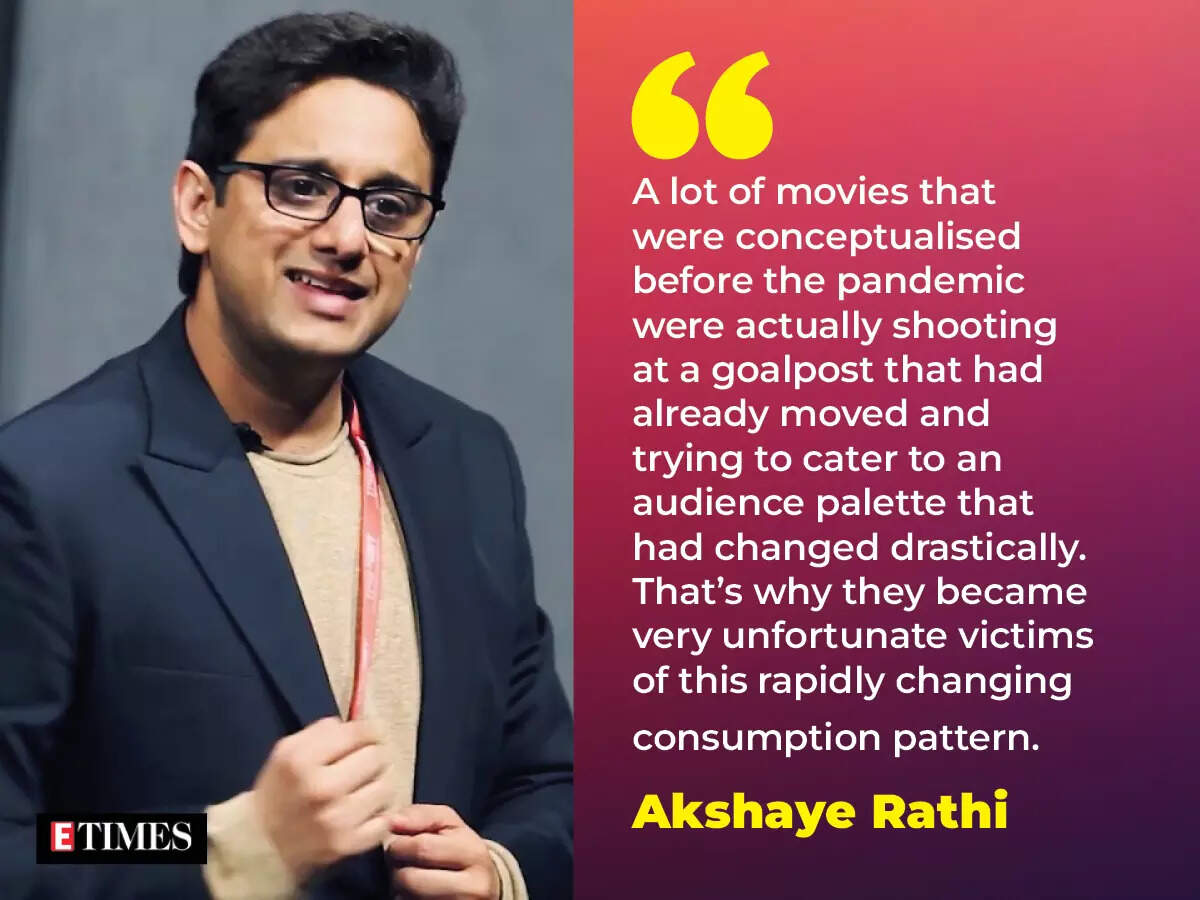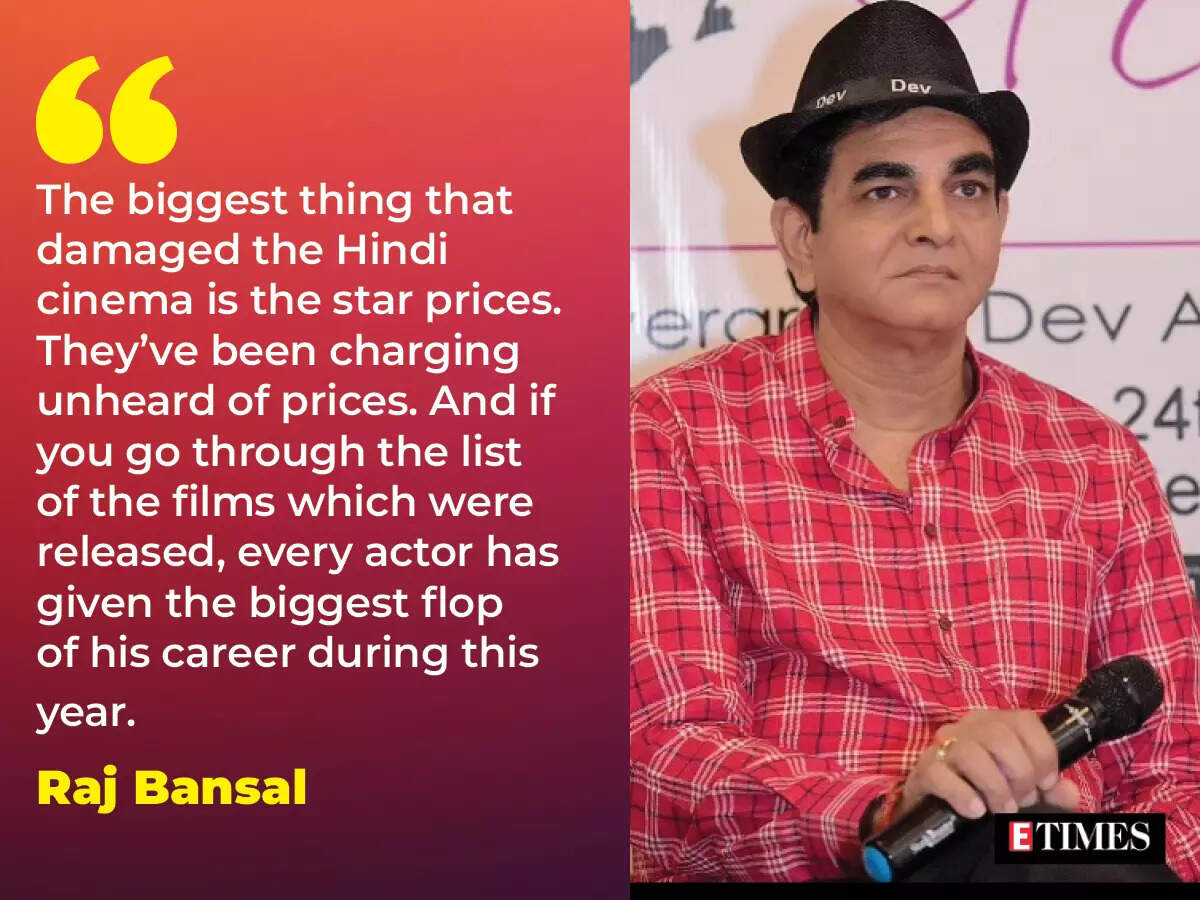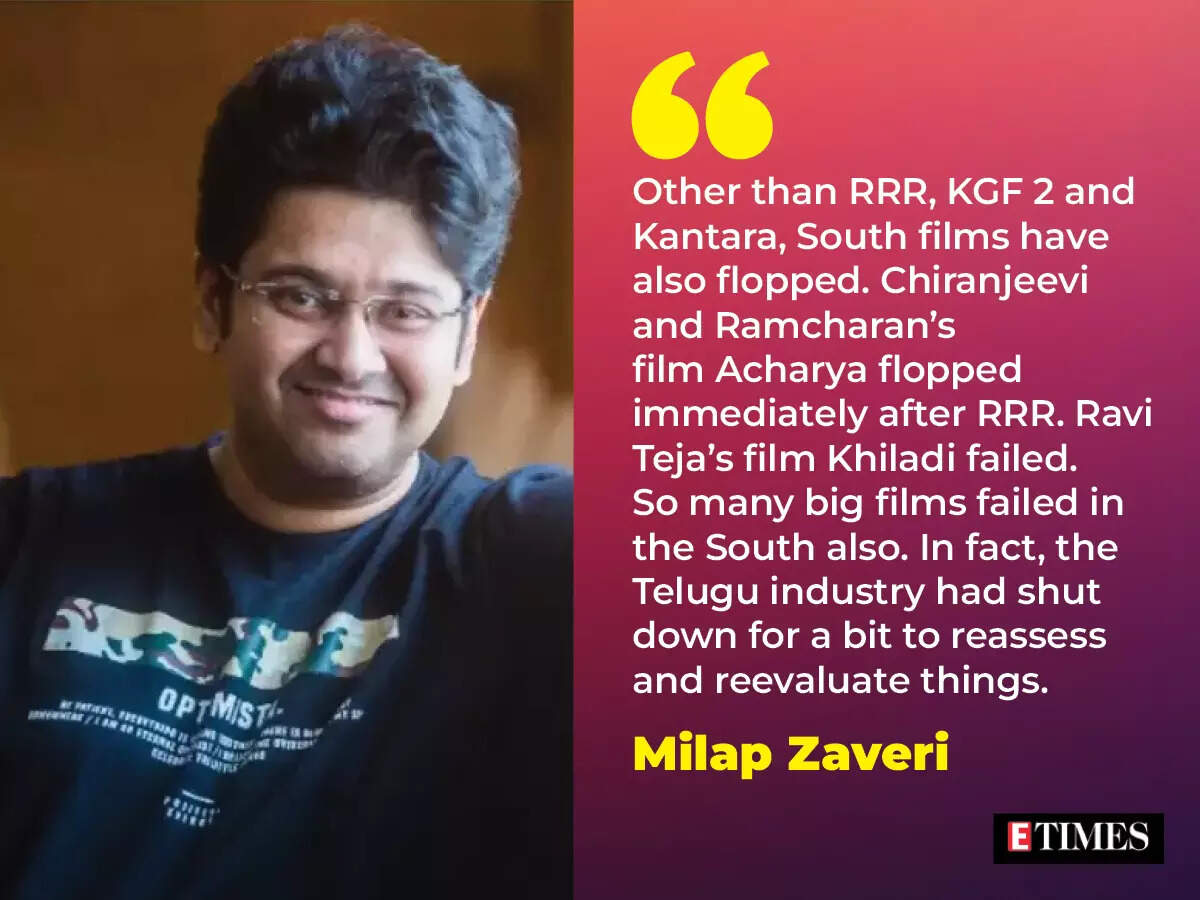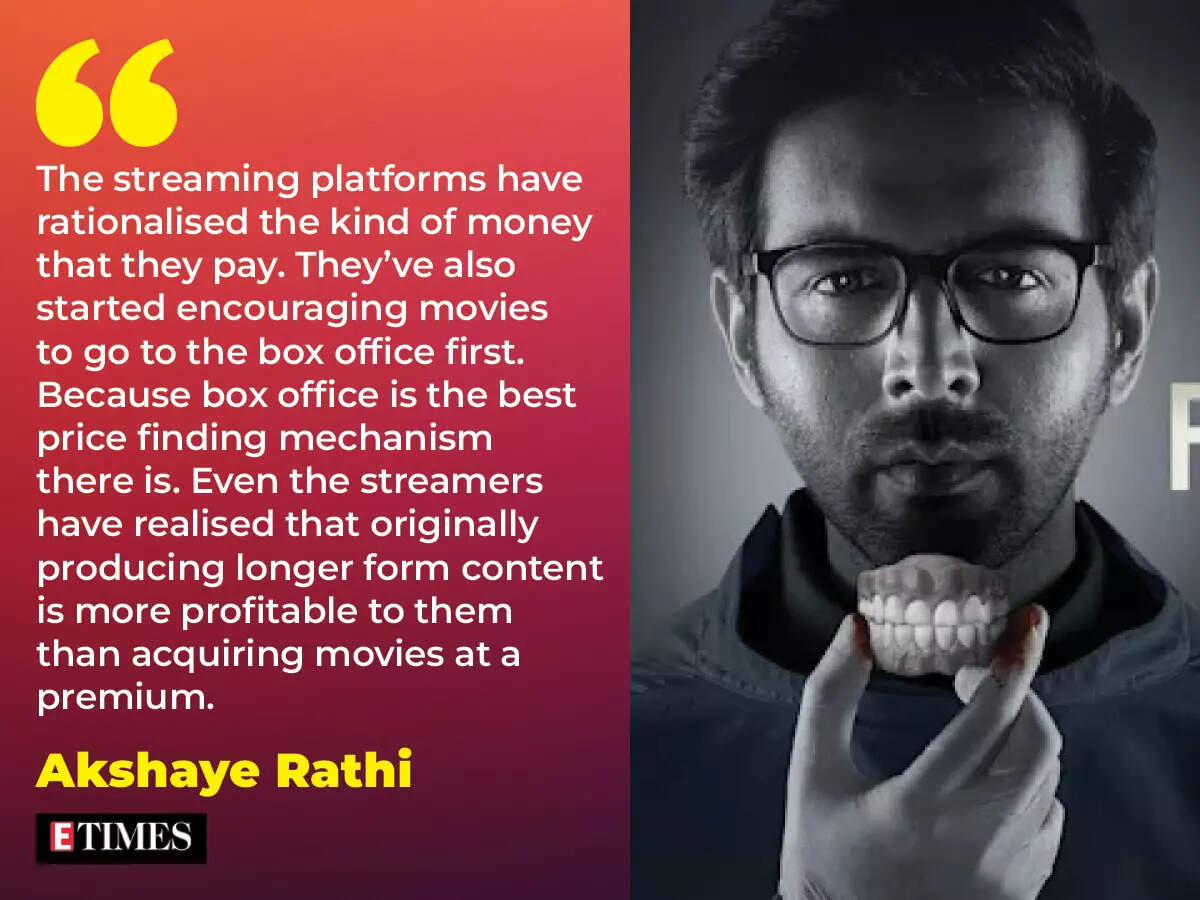
[ad_1]
One look at the movies table below and you’ll agree the aforesaid is not an exaggeration. Of all the Hindi movies released in the year gone by, Bollywood gave merely 5 blockbusters in the form of Drishyam 2, The Kashmir Files, Bhool Bhulaiyaa 2, KGF 2 (Hindi) and Kantara (Hindi). This was closely followed by RRR (Hindi) which was a superhit, and Brahmastra and Gangubai Kathiawadi that were hits. Then comes an exhaustive list of films some of which did an average business at the box office and as many as 39 were disasters, including the big budget movies like Radhe Shyam, Bachchhan Paandey, Jersey, Runway 34, Heropanti 2, Dhaakad, Samrat Prithviraj, Shamshera, Laal Singh Chaddha, Raksha Bandhan, Vikram Vedha, Cirkus among others.
Today’s #BigStory reflects upon the various factors that could have affected the Hindi box office, including the aftereffects of pandemic, the decline of star power, the dominance of South films, the OTT impact. Trade experts and filmmakers also share their learnings from 2022. Read on.
The pandemic effect
Statistics clearly indicate that the success ratio of Hindi films has been adversely affected in the post pandemic times. As media sector analyst Karan Taurani points out, “Only about 12-14% films have become hits in 2022 while the rest have been disappointments. The box office collection of Hindi films was somewhere around 4000 crore nett before the pandemic. In 2022, it has come down to around 3000 to 3200 crore nett. That’s about 80% recovery, which is good news. But the bad news is that the contribution from Hindi films has come down drastically. Out of this 3200 crore, almost 800 crore is contributed by regional films, including Kantara, Ponniyin Selvan I, RRR, and KGF 2. So, if we exclude this, the recovery from Hindi films has been only about 60%. The share of regional content has come up drastically. It was about 30-35% pre-COVID and has come up to 45-50% post-pandemic.”
The problem with Bollywood has been that the content is not clicking with the audience, Karan adds. Trade analyst and film critic Taran Adarsh agrees. “2022 was the worst period. I have seen bleak times in the 90s also, but this year seems to have been worse. The content has clearly failed us. There has been a sudden change in the audience’s taste in the pandemic. People now choose what they want to watch in theatres and what to watch on OTT. And this was bound to happen because the content was so bad.”
Writer-director Milap Zaveri, however, disagrees and points out that 2020-21 were the worst years. “In both the years, no films could release because of the pandemic, and when they released, other than just maybe a few, nothing worked. That way, this year there was Bhool Bhulaiyaa 2, The Kashmir Files, Gangubai Kathiawadi, Brahmastra, Drishyam 2, quite a few films that have done well and succeeded.”
The pandemic forced binge consumption of content on OTT from across the world. But there are some movies that the audience definitely preferred to watch in the theaters. Film analyst and distributor Raj Bansal points out, “OTT was a big setback and films that were released in theatres lost heavily for two reasons – the free supply of entertainment on OTT turned into pay and come into the cinemas, and the quality of the film which Hindi cinema was making was not upto the audience’s tastes anymore.”
Milap Zaveri begs to differ again, “I don’t think people were skeptical because of OTT, otherwise they would have not gone for films like Drishyam 2, Bhool Bhulaiyaa 2 also. Films that are like these big screen entertainers, people preferred to watch those in theaters. One good thing that has happened now is that the window between OTT and theatrical releases has become longer. So if that window is eight weeks or longer it will definitely help.”
Karan Taurani shares some more startling figures. “The footfalls are down drastically, about 25%. One reason, of course, is OTT, but the bigger concern here is content, and not OTT. Before the pandemic, about 20-22 films were released every quarter, but with the OTT coming in, we’re not seeing more than 15 to 17 films every quarter. Secondly, in pre-pandemic times, about 4-5 films made a collection of about 100 crore every quarter, but now that number has increased to 22 films doing the same amount of business in one quarter. Also, earlier, a lot of small-medium budget films did very well. That has seen a massive failure because the OTT window came down from eight weeks to four weeks. It’s back to eight weeks again. In an entire year, we have seen only 3-4 small-medium budget films performing well. In the case of larger films, they did a box office business of 50-100 crore at least. Now, even large star films are doing collections of less than half of what they would do pre pandemic. Laal Singh Chaddha, Raksha Bandhan, Prithviraj are some examples.”
Film analyst and distributor Akshaye Rathi still disagrees that 2022 was the worst year for Bollywood. “In 2004, the only hit that we had was Dino Morea and Bipasha Basu’s Raaz. So there have been worse years,” he says. “This year, in fact, we’ve had Gangubai Kathiawadi, Sooryavanshi, Bhool Bhulaiyaa 2, a couple of other films that did very well. Drishyam 2 did extremely well, Bhediya did reasonably well, JugJugg Jeeyo was fine. So it’s been a mixed year. But yes, what certainly happened is that the movies that didn’t work, didn’t work at all. Right at the beginning when the theaters were opening up all over again with capacities of 50%, we had smash hits like Sooryavanshi and Pushpa. And then we had The Kashmir Files and a couple of others. But then there were also movies that featured some of our big stars that people saw at home. So it wasn’t the audience’s skepticism about stepping into theaters. It was more about which movies are worth watching in the theaters versus which ones worth watching at home,” he says.
Pre-pandemic films backlog
Like everything else the COVID-19 pandemic brought the film industry to a standstill. There were a lot of films shot and planned for a pre-pandemic release were waiting to see the light of day. While some took the OTT route, many others made their way to theatres.
“The films that were made pre-pandemic may have done better had they got a release in 2020 itself. By 2022, the content of these films was already late, whereas the audience had evolved. Too much had changed,” says film producer Ramesh Taurani.
Akshaye Rathi agrees, “I think those two years of sitting at home and watching content from not just the South and other parts of the country, but also stuff that from Korea, Japan, European countries, Iran, and a lot of Hollywood, the palette and the taste of the audience at large changed significantly. And that’s why a lot of movies that were conceptualised before the pandemic were actually shooting at a goalpost that had already moved and trying to cater to an audience palette that had changed drastically. That’s why they became very unfortunate victims of this rapidly changing consumption pattern.”

Milap Zaveri shares a different perspective, “Bhool Bhulaiyaa 2 was planned and shot before the pandemic, it became a blockbuster. Gangubai Kathiawadi and Brahmastra were shot before the pandemic, RRR was planned before the pandemic, it became a superhit. KGF 2 was planned before the pandemic, it became a superhit. So if you see, 90 percent of the releases this year were planned before the pandemic and they still became big blockbusters. So I don’t think that because they were films that were made earlier, they’re not relevant anymore. Most of the successes this year were planned during or before the pandemic.”
Decline of star power
From Akshay Kumar to Shahid Kapoor, Ajay Devgn to Tiger Shroff, Aamir Khan, Hrithik Roshan and Ranveer Singh, many stars witnessed the downfall of their films at the box office. “It was quite shocking,” says trade analyst and film critic Taran Adarsh. “A lot of films had to bite the dust. Stars seemed to have lost their shine. Because star names par log theatre nahi aaye – be it 83 or Cirkus. People didn’t come to watch Bhediya for Varun Dhawan, Jersey for Shahid Kapoor, or Vikram Vedha for Hrithik Roshan.”
Leena Jaisani from FICCI shares that the media and entertainment sector has exceeded its pre-covid high, and has reached its highest ever revenue, with advertising approximating Rs 1 lakh crore. “The time of ‘One market’ is here: The concept of language markets is getting disrupted, as content is crossing language barriers. Movies are resonating irrespective of stars and language barriers, as dubbing, sub-titling and remakes are at an all time high,” she says.
Film producer Tanuj Garg reinstates that it’s only content and not star power that works at the box office. “Films need to be correctly and sensibly priced for the numbers to work. It doesn’t matter whether the films hail from the South or North or who the actor is. If the script and budget are in order, nothing else will matter!”
Raj Bansal believes the biggest thing that damaged the Hindi cinema is the star prices. “They’ve been charging unheard of prices. That is hampering the business. I totally agree that star power has come down which is evident from the films which were released in 2022. And if you go through the list of the films which were released, every actor has given the biggest flop of his career during this year.”

“Star power is definitely on decline,” says Taran Adarsh. “It will remain but it needs to be controlled in terms of economics, in terms of giving them roles that suit their age, in terms of content that looks justifiable on screen. The audience has become very ruthless, they will immediately reject something they don’t like. Look at what happened to Cirkus. The audience rejected the film right after watching the trailer. Same combination – Rohit Shetty and Ranveer Singh in the last release of 2018 – Simmba had taken a flying start.”
Trade analyst, film producer and distributor Girish Wankhede adds, “Star power is declining only because stars just increase their visibility by doing endorsements and meeting the audiences by doing the city travels. And they are not paying much attention to the content. If Laal Singh Chaddha can flop, then you understand that it’s not a good sign.”
Milap Zaveri shares a different opinion. “Drishyam 2 – Ajay Devgn; Brahmastra – Ranbir Kapoor, Alia Bhatt; Bhool Bhulaiyaa 2 – Kartik Aaryan, Gangubai Kathiawadi – Alia Bhatt, JugJugg Jeeyo – Varun Dhawan, Anil Kapoor and others. If we look at it, all the Hindi films that opened this year and done well all are with star power. The Kashmir Files was a complete aberration. Other than that, which other non star cast film had a good opening? I don’t think the star power has waned at all. Even today, Bachchhan Paandey opened to more than 12.5 crore, Ram Setu opened over 15 crore. All these films opened to bigger numbers because there was a certain star in them,” he explains, adding that he is too excited about Pathaan, Kisi Ka Bhai Kisi Ki Jaan, and Tiger 3. “I genuinely have full faith that Pathaan will open very big in January and it will surely be a big boost for everybody,” he says.
Akshaye Rathi too disagrees that star power has declined. “But what has certainly happened is that wasting the audience’s time, money and effort is something that people don’t tolerate anymore,” he says. “Whether a movie features a star, or whether it features a rank newcomer for the audience that it’s reaching out to, I think what the audience definitely wants is their money’s worth and the time’s worth. Now, if that happens with a superstar, the movie goes to a whole different orbit. And if it doesn’t, people still turn up at the cinemas in big numbers. But if you tell them a tale that they don’t want to hear or tell them a tale in a way that they don’t want to hear it in theaters, whether you’re a star or not, they don’t turn up.”
Director Aanand L Rai believes it is not the decline of stars, but it’s about the makers. “I will say the makers have failed the audience. The day there is a good story then you can again regain that stardom. That always has to do with the story. A story well told with conviction will get our star system back.”
South dominance
South films like RRR, KGF 2, Ponniyin Selvan I, Kantara made everyone sit up and take notice. While the Hindi films were struggling at the box office, the South films were getting all the love and adulation of the audience. Raj Bansal explains South took over from Hindi cinema somewhere around Bahubali itself. “With Bahubali business, we were left behind and when the pandemic hit us hard, they were working very hard on the script, on big sets and good performance,” he says.
Taran Adarsh agrees there was big time South dominance in 2022. “They were catering to an all India audience and they were making desi films that were rooted in Indian culture.”
“South people have been known to give newer subjects since time immemorial,” says Komal Nahta. “South has been ahead of Bollywood as far as the thought process is concerned. South writers are definitely more hardworking and more innovative than Bollywood writers. And it got underlined now, because the release of the South dubbed versions was simultaneous with the original versions. So, this new thing happened in 2022.”
“It’s not like the South is dominating, but yes, the South movies are doing a lot better for the simple reason that they’ve never lost connect with the least common denominator of the social strata,” says Akshaye Rathi. “The movies from South still cater to Bharat, while we in the Hindi film fraternity, generally have gone very urban and very multiplexy with our outlook.”
Milap Zaveri, however, notes that other than RRR, KGF 2 and Kantara, South films have also flopped. “Immediately after RRR, Acharya flopped, which was Chiranjeevi and Ramcharan coming together for the first time. Ravi Teja’s film Khiladi failed. So many big films failed in the South also. Recently, Love Today and Ravi Teja’s Dhamaka have done very well. But it’s not like every week they’re giving a hit. In fact the Telugu industry had shut down for a bit to reassess and reevaluate things,” he points out.

Ramesh Taurani agrees, “We tend to remember the hits only. In Hindi, Bhool Bhulaiyaa 2, JugJugg Jeeyo, Drishyam 2, Brahmastra, Gangubai Kathiawadi did well, so we remember these films. We tend to forget the flops. Same thing happened in the South. If films like Pushpa, RRR, KGF have worked, in comparison many other films have flopped.”
Direct to OTT
Looking at the fate of films at the box office, several filmmakers opted for a direct to OTT release of their movies. The OTT operators offered a handsome amount and given the dismal collections at the BO, it seemed like a sensible thing to do. But is the trend here to stay? Karan Taurani sheds some light. “2023 will be much better as compared to 2022 because there is a resurgence in the way the stories are being made in Bollywood now. Direct to OTT releases have gone down.
In the 18 months of the pandemic, we saw about 25 films going direct to OTT. Now, in the last 10 months, we haven’t seen more than 8-10 films going direct to OTT. Now there are different types of films consciously being made for OTT. But the cinematic films going direct to OTT have become half as compared to the pandemic times,” he says.
While there was a surge of direct to OTT releases hampering the theatrical business, most of the OTT releases lacked the charm, notes Girish Wankhede. “Be it Bubbly Bouncer, Freddy, Dial 100, or Monica O My Darling; or Good Luck Jerry and Darlings that were appreciated, you can say if there were 20 releases which were direct to OTT, only 2-3 made the mark. Rest were not good,” he says.
“While we still have a few direct to OTT releases, the streaming platforms have also rationalised the kind of money that they pay to content,” points out Akshaye Rathi. “They’ve also started encouraging movies to go to the box office first. Because box office is the best price finding mechanism there is, even for streaming and satellite. That’s why now you’re hearing of very few movies that are going straight to streaming. Because even the streamers realised that originally producing longer form content is more profitable to them than acquiring movies at a premium, which don’t really add enough subscriptions to their platforms in general.”

Ramesh Taurani adds, “We will now have to think at story level itself whether this is being made for OTT or theatres. Some movies that were supposed to be released in theatres in 2022 had been released directly on OTT. But now the bifurcation has become clear.”
Learnings from 2022
Aanand L Rai faced a major setback with Raksha Bandhan this year. Sharing his learnings from 2022, he says, “I have realised that success cannot teach you as much as failure does. I feel that this is the most important year where we all have learned our lessons with our successes and failures. The kind of detachment we were feeling with our audience, I think now we are getting a clarity where we had gone complacent and we should work on. We should really focus on our story and it’s very important to stay true to it. Don’t run after success, run after a good story and don’t take your audience for granted.”

Milap Zaveri could not have seen a similar fate coming for his last release Satyameva Jayate 2. “The learning is that we have to make better films,” he says. “It can be a big screen spectacle, a thriller, a love story, it can be anything, but we have to make better films. Because one thing that OTT has done, the pandemic has done is make everybody watch a lot more of world cinema and world shows. So obviously, the exposure of our audience is now much more than what it was. And so we have to work harder on our films. Not a single film since the pandemic that has failed, except in my opinion – 83, deserved to be a big success, my film included. Whatever failed in a way would have failed even before the pandemic.”
Ramesh Taurani has Merry Christmas coming ahead. “The content, the story and screenplay have to be strong,” he asserts. “And if there are bigger stars with good stories, it’s sone pe suhaga. Films with big stars, without good content, have not worked in 2022. Woh pehle bhi nahi chalta tha. The audience is watching different types of content on TV and OTT, Hollywood movies, South movie – so the competition is very tough.”
Komal Nahta says there is no shortcut to success. “Content is king, script is the backbone of the films. There is nothing like multiplex audiences are different from single screens – RRR and Pushpa prove that they are also as fond of action films as the masses. So this myth that classes don’t like action films was all the myth, a false theory propagated by the Bollywood people. And they realised that it was a false theory which gained so much ground that everybody started believing in the lies and we stopped making action films. Audience wants entertainment be it action, romcom or anything else. Larger than life films have a better chance of clicking,” he notes.
Raj Bansal shares his learnings, “Three things – you need to have a good story and screenplay, you need to cut the star prices and cut down the ticket pricing.”
Taran Adarsh resonates, “The biggest learning of this year is that you need to concentrate on content and keep the economics in check.”
[ad_2]
Source link

